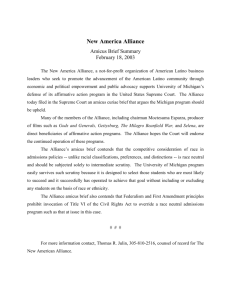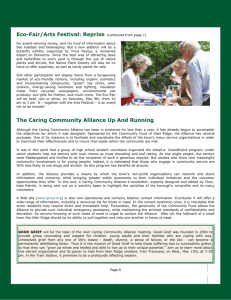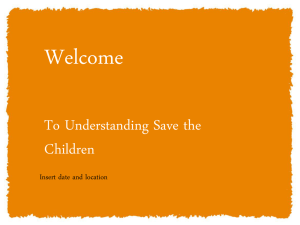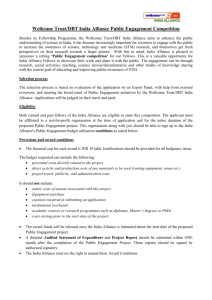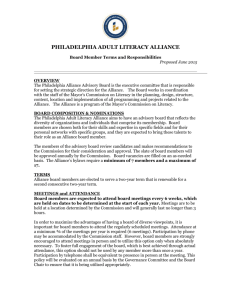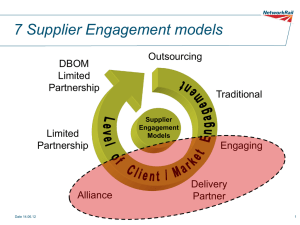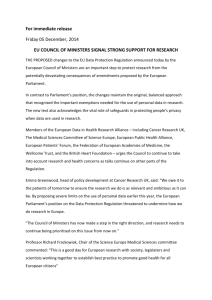The PLACE Alliance - The Farrell Review
advertisement
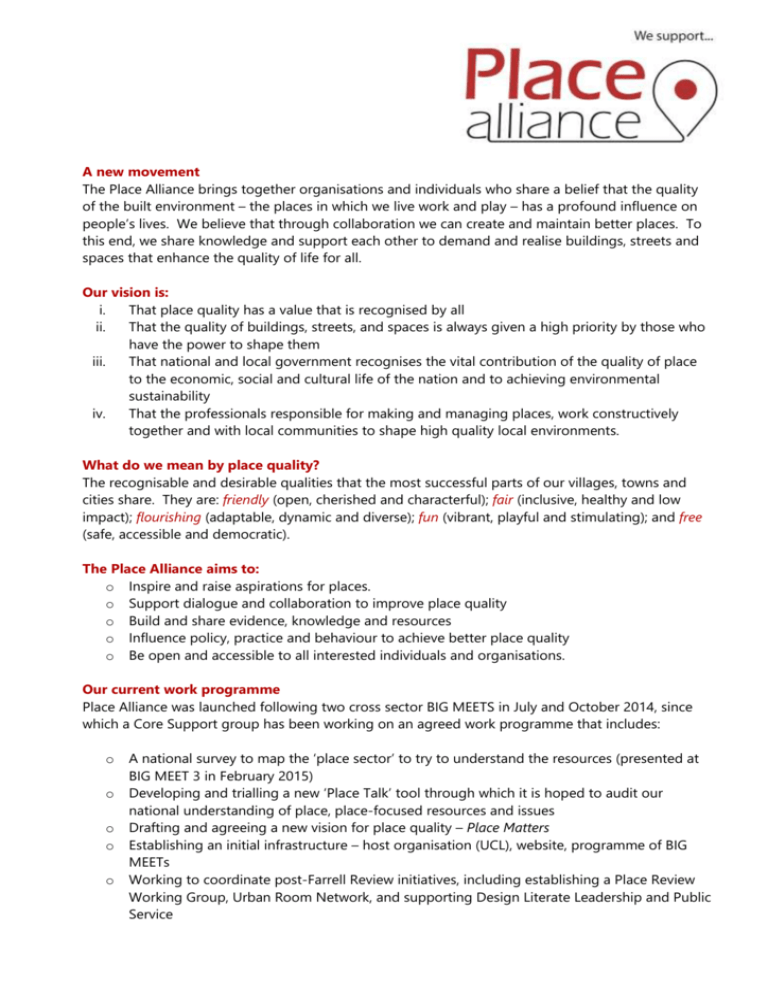
A new movement The Place Alliance brings together organisations and individuals who share a belief that the quality of the built environment – the places in which we live work and play – has a profound influence on people’s lives. We believe that through collaboration we can create and maintain better places. To this end, we share knowledge and support each other to demand and realise buildings, streets and spaces that enhance the quality of life for all. Our vision is: i. That place quality has a value that is recognised by all ii. That the quality of buildings, streets, and spaces is always given a high priority by those who have the power to shape them iii. That national and local government recognises the vital contribution of the quality of place to the economic, social and cultural life of the nation and to achieving environmental sustainability iv. That the professionals responsible for making and managing places, work constructively together and with local communities to shape high quality local environments. What do we mean by place quality? The recognisable and desirable qualities that the most successful parts of our villages, towns and cities share. They are: friendly (open, cherished and characterful); fair (inclusive, healthy and low impact); flourishing (adaptable, dynamic and diverse); fun (vibrant, playful and stimulating); and free (safe, accessible and democratic). The Place Alliance aims to: o Inspire and raise aspirations for places. o Support dialogue and collaboration to improve place quality o Build and share evidence, knowledge and resources o Influence policy, practice and behaviour to achieve better place quality o Be open and accessible to all interested individuals and organisations. Our current work programme Place Alliance was launched following two cross sector BIG MEETS in July and October 2014, since which a Core Support group has been working on an agreed work programme that includes: o o o o o A national survey to map the ‘place sector’ to try to understand the resources (presented at BIG MEET 3 in February 2015) Developing and trialling a new ‘Place Talk’ tool through which it is hoped to audit our national understanding of place, place-focused resources and issues Drafting and agreeing a new vision for place quality – Place Matters Establishing an initial infrastructure – host organisation (UCL), website, programme of BIG MEETs Working to coordinate post-Farrell Review initiatives, including establishing a Place Review Working Group, Urban Room Network, and supporting Design Literate Leadership and Public Service o o Building a network of local Place Alliance hosts utilising our universities Exploring the viability of an Open Source Place Resource website, based on the Trip Advisor model What do we ask from the next Government? Place Alliance is an embryonic movement, but one with significant potential to lead a new focus on place quality. In the short term we would ask the next Government to: o o Publically support our work and engage with us as a new partner for Government Consider match-funding any resources we obtain from our supporters 2 Place matters friendly, fair, flourishing, fun & free While the quality of our local environment matters to all citizens of these islands, in England 90% of us live in urban areasi on just 10% of the landii. As a consequence, we face a continuing challenge; how to shape our villages, towns and cities in a manner that ensures they are attractive places to live that offer the very best life chances and experiences, whilst encouraging our citizens to value existing urban areas and so help reduce pressure for development in unsustainable locations. The power of place Local places are made up of buildings, streets and spaces and their communities of users. Each place is unique, and there is a great diversity and richness across the country. Our experience of place will vary hugely depending on who we are and on where and how we live: whether in a village, town or city; suburban or urban areas; as resident or worker; old or young; and, most profoundly, whether we live in places of prosperity or poverty (the latter occupied by 13 million people in England) iii . Whoever we are, our everyday engagement with the places in which we live, work and play will influence the lives we lead, the opportunities available to us, and our personal and communal happiness, identity and sense of belonging. This experience of place is fundamental to our physical and mental health and sense of wellbeing. Place underpins cultural activities and social opportunities. Place is political, influencing provision of and access to common assets, including infrastructure, public and open spaces, and social and educational services. The quality of places influences and is influenced by housing conditions, real estate markets, and our use of technology. Place has an impact on the way we govern ourselves, on our democracy and local decision-making, on community togetherness and empowerment, and on much, much more. The impacts of place are therefore profound and reverberate throughout the lives of citizens. They begin with the requirement that our local environments are meeting basic human needs, such as a decent and affordable home, a sense of community and belonging, and freedom of movement and safety. They include working collectively from the largest city-wide scale down to the individual street or space to ensure that places enrich our lives and encourage a healthy attachment to localities. Shared local concern for and engagement in the processes of management and change should extend to all local communities as a universal civilising force. A Vision of Place Quality – five ‘F’s Successful local places have in common five ‘F’s. They are: 1. Friendly: Good places feel open and welcoming to all and are liveable in the sense of being fit for everyday life. A key test of this is how they are suited to family life with the full range of social infrastructure required to nurture children and support the different generations of families. They should be pleasing and attractive with a positive character of their own. This is not a question of style, but instead reflective of the fact that certain qualities are universally appealing. These include: a sense of naturalness (water, trees and greenery); a level of detail and visual interest; a human scale; and the distinctive 3 qualities lent by a natural setting, heritage assets, public art and by positive social amenities such as local markets. If places are cherished – well managed – this adds to the impression of attractiveness, helps to nurture respect for place, and reassures users about the social stability of an area. 2. 3. 4. Fair: Inclusive access requires that all sections of society, of all ages and mobilities, can easily and comfortably get to, navigate through, and move around a locality. In such places the layout of the built environment should not unintentionally discriminate against those without private transport. Neighbourhoods should be affordable (to the existing local community), thereby helping to support local friendship and family networks, and healthy: walkable and connected, with access to high quality green open space, clean air and water. Fairness also extends beyond the locality, to reducing impact on the wider environment and society by supporting natural diversity, low carbon emissions, and minimising waste and pollution. Flourishing: The life of a successful place is generated in large part by the sorts of uses it supports, their diversity and the connections between them. Places that are dynamic and responsive to change are more likely to thrive and in the process cultivate a local entrepreneurial spirit. They will offer employment opportunities, support local wealth creation, and help to underpin local facilities and social services. Amongst other qualities, an adaptable physical environment is required that is able to support a diverse mix of use and activities and be responsive to economic and social change and welcoming of new development. Ideally it should do this whilst still providing the security and stability of familiarity through careful conservation and managed change. Fun: Good places should promote joy by adding to the sum total of local happiness. Vibrant places that are full of life and activity are most likely to do this by supporting opportunities for local vitality in all its forms: social, cultural, economic and environmental. A critical component of fun is the opportunity for play, adventure, games and sport, and this should be an integral part of design, not an add-on. Places should be stimulating on a range of levels starting from a formal educational perspective but including opportunities for life-long learning, clubs and societies, and for cultural and spiritual engagement and enrichment. They should offer simple opportunities for everyday socialisation from large public events and festivals to private meetings in local parks, pubs, halls and cafés. 5. Free: A final ‘F’ relates to a set of fundamental freedoms that good places enjoy and which relate to the idea of the public realm as a collective public good in which we all have a stake. These begin with the use of public space as a venue for democratic discourse and debate which needs to be carefully safeguarded, whilst local practices of development and governance should also be democratic; meaning clearly locally accountable and encouraging diverse public engagement with processes of change. The freedom to move around in a convenient way, with pedestrians and cyclists given adequate safe street space, is also key, including access to high quality public transport accessible to all. Finally, personal safety and security provided by an environment in which respect and tolerance predominate and in which citizens, without restriction, are able to go about their daily business free from crime or the fear of crime. The long-term benefits and processes of improving place quality The immediate benefits to local communities of a high quality built environment that reflects the five ‘F’s are clear. Such places offer a more liveable, cohesive, and enjoyable place in which to live and a greater range of local opportunities. Place quality also contributes to benefits to society over the longer term, such as: o The multiplier effects of enhanced local economic development and performance 4 o o o o o o Reduced costs to government of health care, social care, and crime and disorder Reduced environmental costs of congestion, energy use, and pollution Improved resilience and adaptability in the face of social, demographic, environmental, economic and technological change Greater consensus within communities on the need for further development and managing its impact Enhanced social justice through the greater influence of communities on changes that affect them A general rise in aspirations, expectations, local pride, and demand for better quality design. The Place Alliance has been formed as a crosssector collaborative alliance for place quality. Our supporters are engaged in the full range of processes involved in shaping places. These processes are: Notes: o o o o o o Both strategic and local in nature Public and private Top-down and bottom-up Directly and indirectly shaping places (for instance though both projects and policies) Concerned with the environmental, social and economic wellbeing of places and people Professionally and community driven, involving a wide range of professionals and communities. By working constructively and collaboratively as allies within the Place Alliance, we aim to establish a culture whereby place quality becomes a regular fixture in public debate and a continuous and accepted criterion in all new development, regeneration, conservation and urban management processes. https://www.cuf.org.uk/poverty-england iii https://docs.google.com/spreadsheet/ccc?key=0AonYZs4 MzlZbdFk3R1R1aXZPTlROdW9jZUpLZS1xVGc#gid=0 ii http://www.bbc.co.uk/news/uk-18623096 i 5




